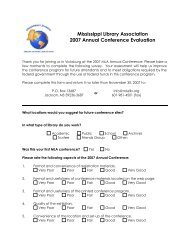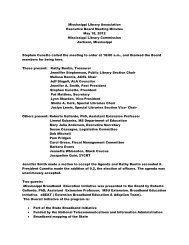Page 5 Vol. 67, No. 1, Spring 2003 <strong>Mississippi</strong> LibrariesQuinn, Patricia O. (Ed.). (1994). ADD andthe College Student: A Guide for HighSchool and College Students with AttentionDeficit Disorder. New York, NY: MaginationPress. (High School and College).(Reviewed in Booklist, 04-01-94).This book focuses on the physiology and manifestationsof ADHD, common treatments, learningaccommodations that students might seek, guidelinesfor finding an “ADHD friendly” college, andthe legal rights of students with ADHD.Quinn, Patricia O. (1995). Adolescentsand ADD: Gaining the Advantage. NewYork, NY: Magination Press. (Grades 8-12). (Reviewed in School <strong>Library</strong> Journal,03-01-96 and Booklist, 01-01-96).In this book Quinn discusses the manifestations ofADHD in adolescents, the academic challenges ofstudents with ADHD, tips for success, and the variousmedications available. The book also offerspersonal stories from adolescents with the disorder.NONFICTION – BOOKSFOR PARENTS WITHCHILDREN WITH ADHD*Alexander-Roberts, Colleen. (1994). TheADHD Parenting Handbook: PracticalAdvice for Parents from Parents. TaylorPublishing.The information was obtained by collecting surveys.Topics covered include the symptoms of ADHD,the chronological patterns of ADHD in children,ways to prevent misbehavior, working with theschool, adolescents with ADHD, and the impact thatADHD children have on their families.*Barkley, Russell A. (2000). TakingCharge of ADHD: The Complete, AuthoritativeGuide for Parents (Revised Edition).New York, NY: Guilford Press. (MLC hasthe 1995 edition of the same title.)An update of the 1995 edition, this book gives anoverview of current thinking and research regardingADHD and outlines medical, educational, andbehavioral techniques for treating the disorder. Itprovides a step-by-step plan for behavior management,information on diagnosis and treatment,strategies for helping children succeed at schooland in social situations.Buntman, Peter. (1998). Living withADHD Children. Center for Family Life.Buntman includes practical information on how toget children to behave and listen to their parents,how to help children with ADHD in the school system,how to deal with parents’ anger, how to buildchildren’s self-esteem, how to get children to go tosleep, and how to improve the home life withADHD children.Giler, Janet. (2000). Socially ADDept: AManual for Parents of Children with ADHDand/or Learning Disabilities. C.E.S.Giler’s book provides information on social skillstraining for children with ADHD and/or learningdisabilities, the parents’ role in helping and guidingtheir children, teaching empathy, and chartingnegative behavior.Glick, Grad L. (1998). ADD/ADHDBehavior-Change Resource Kit: Ready toUse Strategies & Activities for HelpingChildren with Attention Deficit Disorder.Center for Applied Research in Education.This book’s intended audience is teachers, counselors,and parents. It is filled with practical strategiesto help children learn to manage their ownbehaviors and build academic, social, and personalskills. Information is also included on ADHDbehavior, biological bases of the disorder, proceduresused for diagnosis, and treatment options.Nadeau, Kathleen, Littman, Ellen, &Quinn, Patricia. (1999). UnderstandingGirls with Attention Deficit HyperactivityDisorder. Advantage Books.The purpose of this book is to help parents andteachers identify and help girls with ADHD.Toward that end, checklists for preschool, elementary,middle, and high school levels are providedto help recognize girls who may have the disorder.The book also discusses the differences betweenboys and girls with ADHD, educational issues,approaches to treatment, and medication.Weingartner, Paul. (1999). ADHD Handbookfor Families: A Guide to Communicatingwith Professionals. Child WelfareLeague of America, Inc.Weingartner, who is ADHD himself, discusses howit feels to have ADHD, collecting and recordinginformation for a diagnosis of ADHD, medical andpsychosocial interventions, sample behavior modificationplans, strategies for home and school, andmyths and misunderstandings about ADHD.Weiss, Lynn. (1996). Give Your ADDTeen a Chance: A Guide for Parents ofTeenagers with Attention Deficit Disorder.Pinon Press.Weiss provides information on how to determinewhich traits and behaviors are typical of most youngadults and which are specific to ADHD, identifyingand building on young adults’ strength, guidelinesfor disciplining an ADHD young adult and teachingthem to be responsible, and tips on how to helpADHD young adults achieve academic success.*Zeigler, Chris A. (1995). Teenagers withADD: A Parents’ Guide. Bethesda, MD:Woodbine House.Zeigler focuses on understanding ADHD, treatments,common behaviors of young adults withADHD, how to help with academic struggles, andwords from young adults themselves. The bookalso includes a sample behavior management contractand a list of resources.NONFICTION BOOKS FORADULTS WITH ADHDFellman, Wilma R. (1997). The Other Me:Poetic Thoughts on ADD for Adults, Kids,and Parents. Plantation, FL: SpecialityPress, Inc.This book of poems focuses on both the painfuland humorous aspects of ADHD.*Hallowell, Edward, & Ratey, John.(1994). Driven to Distraction: Recognizingand Coping with Attention Deficit Disorderfrom Childhood through Adulthood. NewYork, NY: Touchstone.Hallowell and Ratey provide a definition of ADHD,traits associated with the disorder, diagnostic criteria,treatment options, and coping strategies. Theyprovide a comparison of the medications commonlyused in treating ADHD. (See also the titleAnswers to Distraction.)*Kelly, Kate, & Ramundo, Peggy. (1995).You Mean I’m Not Lazy, Stupid or Crazy?!:A Self-Help Book for Adults with AttentionDeficit Disorder. New York, NY: Scribner.Kelly and Ramundo focus on the types of ADHD,the impact of growing up with ADHD, the diagnosisand treatment of ADHD, interacting in groupsand on the job, dating, family relationships, andthe organization of tasks.Solden, Sari. (1995). Women with AttentionDeficit Disorder: Embracing Disorganizationat Home and in the Workplace.Underwood Books.Solden focuses on the many girls and women withADHD who have gone undiagnosed because theysuffer from the inattentive type of the disorderrather than the hyperactivity type that typically garnersthe most notice. She discusses the emotionalramifications of the disorder, self-assessment anddiagnosis, restructuring personal relationships, andredefining one’s self-image.*Weiss, Lynn. (1997). Attention DeficitDisorder in Adults. Dallas, TX: Taylor PublishingCompany.Weiss provides information on what ADHD is, thedifficulties in diagnosis, various diagnostic criteria,an example of the visualization technique she oftenuses in treating clients with ADHD, information forfamily, friends of a person with ADHD, and coworkers.(See also the title A.D.D. on theJob: Making Your A.D.D. work for you.)*Indicates titles owned by the <strong>Mississippi</strong> <strong>Library</strong>CommissionIf you are an employee of a state agency, you mayborrow the titles directly from the <strong>Mississippi</strong> <strong>Library</strong>Commission by calling Glenda Tilson, TechnicalServices Branch Director, at 1-800-647-7542 or 1-601-961-4124 or by e-mailing her atgtilson@mlc.lib.ms.us.
<strong>Mississippi</strong> Libraries Vol. 67, No. 1, Spring 2003 Page 6Providing Quality <strong>Library</strong> Servicesfor Students with DisabilitiesBy Mary Beth ApplinInformation Services LibrarianUSM LibrariesUniversity of Southern <strong>Mississippi</strong>Mary.Applin@usm.eduINTRODUCTIONPublic Law 94-142 (1975) and theAmericans with Disabilities Act (ADA1990) ensure that persons with a disabilityare given equal access to educationand other public services. In terms ofschool and college libraries, this meansthat libraries are not only physically accessibleto users but that the delivery of allservices is adequately adapted to meet thespecial needs of these individuals.The Digest of Education Statistics,2001 reports that public school enrollmentof students with disabilities was13% in the year 2000. At the collegelevel, enrollment numbers for studentswith disabilities rose to 9% in 2000(NCES). Statistically, about two-thirds ofthese students will have some sort ofphysical disability (orthopedic, hearing,visual or speech). What do these numbersmean for libraries and librarians?Well, chances are that at least 10 in every100 students that visit a school or collegelibrary will have some type of measurabledisability. Six of those 10 will probablyneed some sort of adaptation to assist thestudent in accessing information. Is yourlibrary ready to meet their needs?PROVIDING EQUAL ACCESSMany libraries do not worry aboutserving a person with a disability until theneed arises. By then, people are scurryingfor information, trying to find someonewho knows what the library’s policyis, what services the library has availableand/or what the library should do if itcannot accommodate a need. Soundfamiliar? Although a library may never beequipped to accommodate every specialneed, it can proactively prepare to providethe best service possible. Here aresome recommended actions every libraryshould adopt in order to ensure personswith disabilities are provided access andquality service:• Form an advisory committee consistingof a librarian, a school official(such as a representative from theOffice of Disability Services), a libraryuser with a disability and maybe someonefrom a local non-profit office servingpeople with disabilities. The committeeshould evaluate the library’scurrent status in terms of accommodations,develop policies and proceduresfor serving persons with special needs,and formulate a plan for best meetinganticipated needs.• Designate a librarian to be an officialcontact for employees and library userswho have questions or problems interms of the library’s disability services.This person would answer questionsconcerning library policies, be familiarwith the library’s adaptive equipment,and provide training for staff.• Provide annual training for employeesregarding the library’s disability servicespolicies and procedures, assistivehardware and software, and sensitivityissues. Libraries can invite speakersfrom local service agencies (e.g. ARC,Vocational Rehab) for presentationson disability awareness and sensitivityissues. This training would serve toinform employees concerning the specialneeds of people with disabilitiesand help them feel more comfortableinteracting with them. The library’sdesignated contact person can alsoprovide employees with training specificto the library’s policies/proceduresand available services.• Become familiar with basic accessibilityfeatures that are built into manysoftware products including Windows,Word, Internet Explorer and NetscapeCommunicator. Adaptive hardwareand software which provides computeraccess to persons with disabilities isexpensive. And though adaptiveequipment is essential, many basicsoftware programs come with built-inaccessibility features that can accommodatesimple needs. For instance,for someone with a slight visualimpairment, Microsoft Windows (98and 2000) comes equipped with aMagnifier (found in the Start menuunder >Programs, >Accessories,>Accessibility) which enlarges the textor image on the screen in a narrowwindow along the top of the screen.Other features found in Windowsinclude Sticky Keys (all Windowsproducts) designed for people whohave difficulty holding down two ormore keys at a time and Sound Sentry(all Windows products) which generatesvisual warnings, such as a blinkingtitle bar or a screen flash, wheneverthe computer generates a sound.(See Table for a list of some otherbuilt-in software features.)CONCLUSIONLibraries have a legal responsibility toprovide equal access and appropriateaccommodations to persons with disabilities.Knowing what accommodations areneeded and budgeting to provide suchaccommodations can be difficult if alibrary does not take a proactive approach.A few simple provisions can make the differencebetween quality and substandardservice. By establishing a plan, providingemployee training, and designating a staffperson as an information conduit, librariescan better prepare to provide the servicesadequately adapted to meet the special
- Page 8 and 9: Page 7 Vol. 67, No. 1, Spring 2003
- Page 10 and 11: Page 9 Vol. 67, No. 1, Spring 2003
- Page 12: Page 11 Vol. 67, No. 1, Spring 2003
- Page 15 and 16: Mississippi Libraries Vol. 67, No.
- Page 17 and 18: Mississippi Libraries Vol. 67, No.
- Page 19 and 20: Mississippi Libraries Vol. 67, No.
- Page 21 and 22: Mississippi Libraries Vol. 67, No.
- Page 23 and 24: Mississippi Libraries Vol. 67, No.
- Page 25 and 26: Mississippi Libraries Vol. 67, No.
- Page 27 and 28: Mississippi Libraries Vol. 67, No.
- Page 29 and 30: Mississippi Libraries Vol. 67, No.
- Page 31 and 32: MISSISSIPPI LIBRARYASSOCIATIONMEMBE














